Related Research Articles

Petersburg is a census-designated place (CDP) in and essentially the borough seat of Petersburg Borough, Alaska, United States. The population was 3,043 at the 2020 census, up from 2,948 in 2010.

Fishery can mean either the enterprise of raising or harvesting fish and other aquatic life; or more commonly, the site where such enterprise takes place. Commercial fisheries include wild fisheries and fish farms, both in freshwater waterbodies and the oceans. About 500 million people worldwide are economically dependent on fisheries. 171 million tonnes of fish were produced in 2016, but overfishing is an increasing problem — causing declines in some populations.

Overfishing is the removal of a species of fish from a body of water at a rate greater than that the species can replenish its population naturally, resulting in the species becoming increasingly underpopulated in that area. Overfishing can occur in water bodies of any sizes, such as ponds, wetlands, rivers, lakes or oceans, and can result in resource depletion, reduced biological growth rates and low biomass levels. Sustained overfishing can lead to critical depensation, where the fish population is no longer able to sustain itself. Some forms of overfishing, such as the overfishing of sharks, has led to the upset of entire marine ecosystems. Types of overfishing include: growth overfishing, recruitment overfishing, ecosystem overfishing.
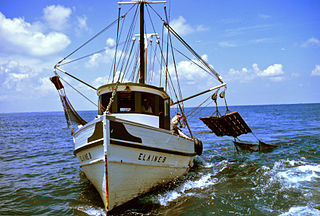
The fishing industry includes any industry or activity concerned with taking, culturing, processing, preserving, storing, transporting, marketing or selling fish or fish products. It is defined by the Food and Agriculture Organization as including recreational, subsistence and commercial fishing, and the related harvesting, processing, and marketing sectors. The commercial activity is aimed at the delivery of fish and other seafood products for human consumption or as input factors in other industrial processes. The livelihood of over 500 million people in developing countries depends directly or indirectly on fisheries and aquaculture.
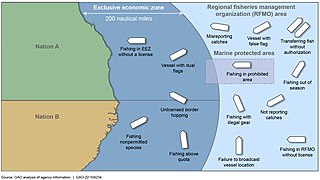
Illegal, unreported and unregulated fishing (IUU) is an issue around the world. Fishing industry observers believe IUU occurs in most fisheries, and accounts for up to 30% of total catches in some important fisheries.

The fishing industry in Scotland comprises a significant proportion of the United Kingdom fishing industry. A recent inquiry by the Royal Society of Edinburgh found fishing to be of much greater social, economic and cultural importance to Scotland than it is relative to the rest of the UK. Scotland has just 8.4 per cent of the UK population but lands at its ports over 60 per cent of the total catch in the UK.

Canada's fishing industry is a key contributor to the success of the Canadian economy. In 2016, Canada's fishing industry exported $6.6 billion in fish and seafood products and employed approximately 72,000 people in the industry. Aquaculture, which is the farming of fish, shellfish, and aquatic plants in fresh or salt water, is the fastest growing food production activity in the world and a growing sector in Canada. In 2015, aquaculture generated over $1 billion in GDP and close to $3 billion in total economic activity. The Department Of Fisheries and Oceans (DFO) oversees the management of Canada's aquatic resources and works with fishermen across the country to ensure the sustainability of Canada's oceans and in-land fisheries.

Until the 1960s, agriculture and fishing were the dominant industries of the economy of South Korea. The fishing industry of South Korea depends on the existing bodies of water that are shared between South Korea, China and Japan. Its coastline lies adjacent to the Yellow Sea, the East China Sea and the Sea of Japan, and enables access to marine life such as fish and crustaceans.
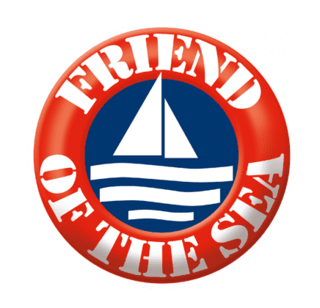
Friend of the Sea is a project of the World Sustainability Organization for the certification and promotion of seafood from sustainable fisheries and sustainable aquaculture. It is the only certification scheme which, with the same logo, certifies both wild and farmed seafood.

The coastline of the Russian Federation is the fourth longest in the world after the coastlines of Canada, Greenland, and Indonesia. The Russian fishing industry has an exclusive economic zone (EEZ) of 7.6 million km2 including access to twelve seas in three oceans, together with the landlocked Caspian Sea and more than two million rivers.
Catch share is a fishery management system that allocates a secure privilege to harvest a specific area or percentage of a fishery's total catch to individuals, communities, or associations. Examples of catch shares are individual transferable quota (ITQs), individual fishing quota (IFQs), territorial use rights for fishing (TURFs), limited access privileges (LAPs), sectors, and dedicated access privileges (DAPs).
Seafood in Australia comes from local and international commercial fisheries, aquaculture and recreational anglers. It is an economically important sector, and along with agriculture and forestry contributed $24,744 million to Australia's GDP in year 2007–2008, out of a total GDP of $1,084,146 million. Commercial fisheries in Commonwealth waters are managed by the Australian Fisheries Management Authority, while commercial and recreational fishing in state waters is managed by various state-level agencies.
Sustainable sushi is sushi made from fished or farmed sources that can be maintained or whose future production does not significantly jeopardize the ecosystems from which it is acquired. Concerns over the sustainability of sushi ingredients arise from greater concerns over environmental, economic and social stability, and human health.
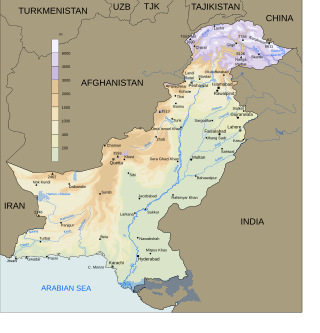
Fishery and fishing industry plays a significant part in the national economy of Pakistan. With a coastline of about 1,120 km, Pakistan has enough fishery resources that remain to be developed. Most of the population of the coastal areas of Sindh and Balochistan depends on fisheries for livelihood. It is also a major source of export earning.
The following outline is provided as an overview of and topical guide to fisheries:
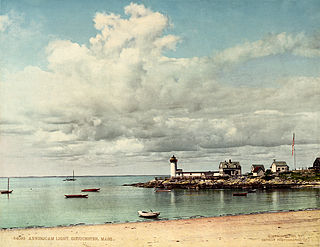
Gloucester Fishermen's Wives Association (GFWA), also known as the Fishermen's Wives of Gloucester (Association), is a non-profit organization "promoting the New England fishing industry, helping to preserve the Atlantic Ocean as a food supply for the world, and assisting active and retired fishermen and their families to live better lives".

Fisheries law is an emerging and specialized area of law. Fisheries law is the study and analysis of different fisheries management approaches such as catch shares e.g. Individual Transferable Quotas; TURFs; and others. The study of fisheries law is important in order to craft policy guidelines that maximize sustainability and legal enforcement. This specific legal area is rarely taught at law schools around the world, which leaves a vacuum of advocacy and research. Fisheries law also takes into account international treaties and industry norms in order to analyze fisheries management regulations. In addition, fisheries law includes access to justice for small-scale fisheries and coastal and aboriginal communities and labor issues such as child labor laws, employment law, and family law.
The Fisheries Law Centre (FLC) is a grassroots non-profit research centre headquartered in Vancouver, British Columbia, Canada. Although FLC is based in Canada, its outreach is global with researchers located in many countries around the world. FLC aims to ensure family fishermen’ access to justice, to protect marine environment, to help coastal communities become more resilient, and to assist consumers in accessing safe and sustainable seafood through research, education, and legal representation.
Gulf Wild is a nonprofit organization operating in the Gulf of Mexico. Gulf Wild works with commercial fishermen to encourage and facilitate fishery conservation and innovation. Gulf Wild has implemented traceability practices including placing a numbered gill tag on every Gulf Wild fish. This numbered tag tracks who harvested the fish, from where, and at what port the fish landed. Consumers can use the gill tag number to access this information via the Gulf Wild website.
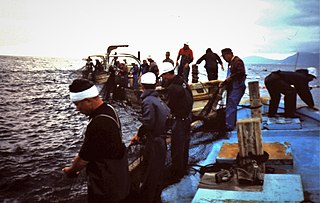
A fishery cooperative, or fishing co-op, is a cooperative in which the people involved in the fishing industry pool resources, in their certain activities from farming, catching, distribution, and marketing of fish.
References
Notes
- 1 2 Witter, Allison. (2012) "Local Seafood Movements and Seafood Sustainability in North America."
- 1 2 "Local Catch". Archived from the original on 2013-06-09. Retrieved 2013-05-30.
- ↑ Brinson, A. et al. (2011). Direct marketing strategies: The rise of community supported fishery programs. Marine Policy 35 542–548
- ↑ CSF able to eliminate by-catch
- ↑ Andreatta, S. (2007) Harnessing Consumer Preferences to Create New Markets for North Carolina Seafood. Fishery Resource Grant Program.
- ↑ Andreatta, S. (2008) Harnessing Consumer Preferences to Create New Markets for North Carolina Seafood - Year Two. Fishery Resource Grant Program.
- ↑ Landis, Benjamin Young (2010). Community Supported Ingenuity. Coastwatch magazine.
- ↑ Campbell, D. (2008) Community-supported Fishery Project: Charting a New Course. Rural Cooperatives. US Department of Agriculture.
- ↑ "From Dock To Dish: A New Model Connects Chefs To Local Fishermen". NPR.org. Retrieved 2017-08-25.
- ↑ Weitz, Emily J. (2014-09-05). "Getting the Catch Directly to the Restaurant". The New York Times. ISSN 0362-4331 . Retrieved 2017-08-25.
- ↑ "Goal 14 .:. Sustainable Development Knowledge Platform". sustainabledevelopment.un.org. Retrieved 2017-08-25.
- ↑ "Fish Out of Water: How One Prairie Town Built an Alaskan Salmon Pipeline". Civil Eats. 2016-07-01. Retrieved 2019-10-08.
- ↑ "A pandemic success story, Sitka Salmon Shares closes plant as sales tumble during the recovery". KCAW. Retrieved 2023-02-11.
- ↑ "Sitka Salmon Shares - Wild Alaskan Seafood, Delivered". Sitka Salmon Shares - Wild Alaskan Seafood, Delivered. Retrieved 2019-10-08.
- 1 2 Brook Lyndhurst (January 2016). "Community Supported Fisheries". Archived from the original on 5 December 2017. Retrieved 4 December 2017.
- ↑ "Catchbox Worthing Facebook Page". Facebook. Retrieved 4 December 2017.
- ↑ "SoleShare Website". SoleShare. Retrieved 4 December 2017.
- ↑ NFWF Announces 2013 Grants for Sustainable Fisheries. April 30, 2013. Scaling 'Local Catch Monterey Bay' to Serve Neighboring Community Fishing Associations (CA). National Fish and Wildlife Foundation.
Further reading
- McGoodwin JR (2001) Understanding the cultures of fishing communities. A key to fisheries management and food security FAO Fisheries, Technical Paper 401. ISBN 978-92-5-104606-7.
- Real Good Fish - CSF Champion of Change
- A Growing Movement for Community Supported Fisheries New York Times, October 2012
- Beyond Red Lists: The Power of Community Supported Fisheries, Grist, 2012
- Local Co-op Helping Keep Alive the Fishing Community
- Cape Ann Fresh Catch Earns New Honor
- The Food Staff's Favorite Things of 2009 - Community Supported Fisheries
- Community Supported Ingenuity, Coastwatch, Winter 2010
- Keeping Local Seafood Afloat: Workshop Explores Consumer Trends And Marketing Strategies Coastwatch, Early Summer 2008
- Carteret Catch: New Marketing Project Promotes Local Seafood Coastwatch, Holiday 2005
- Boat-to-Table Fishing CSAs Catching On YES! Magazine, by Ellen Tyler and Daniel Fireside, Winter 2010
- Community-Supported Fisheries EcoTippingPoints.org

